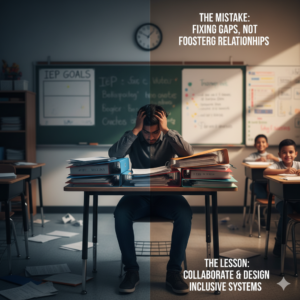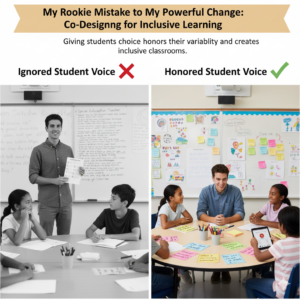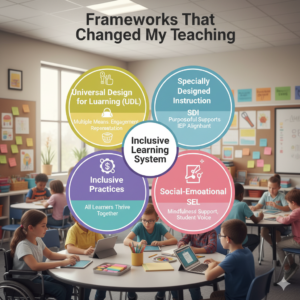Every new teacher in special education carries a story about the one mistake that shaped their career. Mine was painful but transformative. My Rookie Mistake in Special Education wasn’t about lacking knowledge—it was about misapplying it. I walked into the classroom determined to “fix” academic gaps with scaffolds and modifications, while overlooking the need to foster relationships, collaborate, and design inclusive practices.
That rookie error nearly broke me. Students disengaged, families grew distant, and I felt like I was spinning my wheels. But in hindsight, it was the most valuable lesson of my teaching journey.
Early in my career, I thought my role was to solve deficits fast. That meant overloading students with scaffolds, heavily modifying tasks, and relying on IEP matrices without really considering the bigger picture of their lives.
I treated the classroom like a place for remediation instead of a community where diverse learners could thrive.

I didn’t ask students how they wanted to learn. Instead, I imposed supports that seemed logical to me.
When I began co-designing communication tools with students—simple checklists, reflection cards, or even voice recordings—they took more ownership. Their self-advocacy grew.
Action Tip: Add exit tickets like:
Giving students choice honors their variability and creates inclusive classrooms.

Families are the ultimate experts on their children, but in my rookie days, I treated them as passive recipients of updates instead of collaborators.
When I built trust, families became allies in creating consistent supports, from school to home.
I thought layering on support—visuals, prompts, sentence starters—was always a good thing. But I rarely removed those supports, so students became dependent.
I worked in a silo. I didn’t align with general education teachers or therapists. I felt special education was “my responsibility.”
When I started collaborating with general education teachers, planning inclusive practices together, everything shifted. Students benefited from consistent strategies across environments, and we created truly inclusive classrooms.
Collaboration Checklist:
UDL allowed me to design lessons around student variability. By offering multiple means of engagement, representation, and expression, fewer students needed one-off accommodations.
Instead of blanket modifications, SDI helped me align supports with specific goals in students’ IEP matrices. Supports were purposeful, not overwhelming.
Building an inclusive system means students with diverse strengths and support needs learn alongside peers. This doesn’t just serve students with disabilities—it benefits all learners.
Embedding relational check-ins, mindfulness routines, and student voice opportunities supported the whole child, not just academics.

When you enter a new classroom or start working with a student, the urge is to fix things fast. But rushing often leads to the wrong support. Pausing gives you time to notice patterns: how students respond to peers, what motivates them, and where they naturally struggle. Observation helps you design supports that actually match their needs rather than overwhelming them with blanket accommodations
Instead of seeing a child only through the lens of their deficits (what they can’t do), focus on what they can do. This “asset lens” mindset shifts the narrative: the student who struggles with reading might be a great problem-solver in math, or a creative thinker in art. By emphasizing strengths, you build confidence, create buy-in, and show families and colleagues that the child’s abilities matter as much as their needs.
Students are not passive recipients of instruction—they’re active partners. Reflection tools like exit tickets, quick surveys, or digital check-ins give them space to share what’s working and what isn’t. When students tell you, “This strategy helped me” or “I’d rather show my work by drawing than writing,” you gain insight into their learning preferences. Honoring their voice builds ownership and self-advocacy skills.
Families bring a perspective that teachers can’t see in the classroom: daily routines, cultural context, and strategies that work at home. Engaging them early means you’re not just reporting deficits during IEP meetings—you’re building an alliance. Simple actions like calling to share a success, asking, “What motivates your child?” or co-creating a home-school communication tool turn families into collaborators instead of bystanders.
Scaffolding is like training wheels: it helps students succeed while they’re still learning a skill. The mistake is leaving those supports in place forever. Intentional scaffolding means adding supports that directly connect to goals—and planning ahead to remove them as the student grows. For example, a sentence starter may eventually become a checklist, then fade entirely as independence develops.
Universal Design for Learning (UDL) is about planning for variability from the start. Instead of retrofitting lessons, you build flexibility in: multiple ways to engage students (like discussions, visuals, or games), multiple ways to represent content (text, audio, visuals), and multiple ways for students to show mastery (writing, speaking, projects). This reduces barriers and ensures diverse learners can access content without needing constant one-off accommodations.
Special education can’t work in isolation. When general education teachers, speech therapists, occupational therapists, and counselors align their strategies, students get consistency across environments. Weekly co-planning sessions, shared communication logs, and common goals make the system inclusive rather than fragmented. True collaboration ensures the classroom feels like one unified team supporting the student, not a patchwork of disconnected efforts.
FAQs About My Rookie Mistake in Special Education
Q1: Is scaffolding bad?
Not at all. Scaffolding is vital—but only when it’s intentional, aligned to SDI, and paired with fading.
Q2: How do I involve families effectively?
Keep it simple: short updates, positive notes, and early invitations to co-design strategies.
Q3: Does UDL replace IEPs?
No. UDL reduces barriers for all students, but individualized goals and supports from IEPs remain essential.
Q4: How do I track progress beyond academics?
Use ecological inventories, reflection tools, and self-advocacy logs alongside grades.
Q5: What if colleagues resist inclusive practices?
Model them. Share student outcomes and articles like Novak Education’s reflections to create a common language.
My Rookie Mistake in Special Education was rushing to fix problems without first building trust, collaboration, and inclusive systems. What I’ve learned is that real progress comes from honoring student variability, involving families, and embedding UDL and SDI into daily practice.
The truth is, mistakes are part of the journey. But if you can learn from mine, you’ll skip the burnout and go straight to creating classrooms where diverse learners not only participate but thrive.
External Resource: For more on inclusive practices and Universal Design for Learning, visit CAST.org.